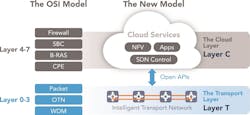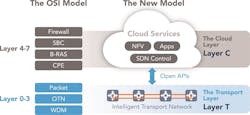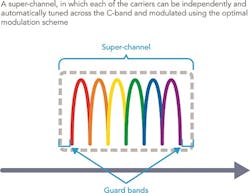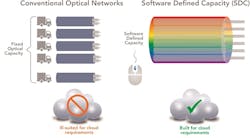Building the Foundation for Cognitive Networking
Fast-paced migration to the cloud, forthcoming 5G deployments, and the proliferation of internet-connected devices driven by Internet of Things (IoT) are fueling the migration toward cognitive networking. Cognitive networks use advanced analytics, machine learning, and artificial intelligence techniques to help build self-optimized, self-healing and highly autonomous transport networks, setting new benchmarks in scalability, agility and automation.
This article describes the journey to cognitive networking by explaining its key building blocks, such as software defined capacity (SDC), multi-layer software-defined networking (SDN) control, and transport technology breakthroughs that make the creation and the deployment of cognitive networks a fast-approaching reality.
What Is Cognitive Networking?
Cognitive networking is the ultimate goal for the intelligent transport layer that underpins all cloud-based digital communications. By definition, a cognitive network is multi-layer, self-aware, self-organizing, and self-optimizing, and can take predictive and/or prescriptive action based on what it has gleaned from its collected data and experience. Realistically, no network can completely plan or run itself; however, cognitive networking will dramatically reduce the number of manual tasks required across a multi-layer network. This goal can be achieved by leveraging advanced software, streaming telemetry, big data with machine learning, and analytics to autonomously conduct network operations to meet the demand for connectivity, maximize network resources, and increase reliability.
There are multiple important elements in a cognitive network, such as:
- Advanced analytics designed to parse streams of machine data to monitor network health and raise awareness of any anomalies
- Machine learning software tools that leverage advanced analytics to understand and identify trends in operations
- Autonomous hardware and software capable of executing various tasks and conducting required maintenance
- Predictive intelligence tools capable of identifying potential problems before they happen
- Prescriptive software tools designed to proactively recommend new solutions for maximizing capacity, enhancing reliability, and optimizing assets.
Cognitive networking is the result of seamless and highly dynamic interaction between software and hardware assets across network layers and brings optical networking to a new level of scalability, flexibility, and automation. The following section describes how to build the foundation for cognitive networking by using the latest technology breakthroughs.
Paving the Way for Cognitive Networking
The journey to cognitive networking starts by building the foundation of a highly scalable, flexible, and programmable network architecture. The building blocks for this foundation are described in the following:
Evolve the network architecture. A well-defined architecture dictates how networks are planned, operated, and evolved. Today, when content is king and must be accessible anywhere, anytime, and on any device with the highest level of quality, it is clear that the 1980s-era seven-layer Open Systems Interconnection (OSI) model has reached a tipping point. It needs to support the transformation in networks (e.g., network functions virtualization [NFV], SDN, etc.) and the new service delivery model based on cloud applications, service virtualization, etc.
The OSI model’s heritage of function- and layer-specific network definitions led to closed and proprietary protocols, rigid networking capabilities, and high operational costs. These limitations have sparked an urgent need to evolve toward a simpler, more efficient and agile architectural model to accelerate the adoption of cloud-based networking. Thus, the first step in paving the way for cognitive networking consists of evolving the network architecture to a simpler cloud-powered model: a cloud services layer, Layer C, and an intelligent transport layer, Layer T, as depicted in Figure 1.
This new model consolidates and simplifies cloud service delivery and networking into two layers, wherein all the OSI networking layers (Layer 3 and below) are represented by Layer T, while all the application layers (Layer 4 and above) are grouped under Layer C. Layer T sets the guidelines and principles for the transport of data streams, whether between end users and data centers or among multiple data centers with bursty and often unpredictable traffic patterns. It also defines the features and capabilities that increase network agility and performance and sets new benchmarks for service delivery and cost-effectiveness, key ingredients to the successful deployment of any cloud application.
Layer Ccontains all the applications, functions, and services that run in the cloud, including consumer and business applications, SDN-based service creation and orchestration tools, software frameworks and applications for big data and machine learning, virtualized network functions (VNFs), and many others, to enable the large-scale task automation and programmability that streamline operations, eliminate human error, and reduce operating costs.
Unlock the network’s full capacity through super-channels. DWDM technology disrupted the telecommunication industry by enabling multiple optical carriers to travel in parallel on a fiber, thus increasing capacity and maximizing fiber utilization. However, the current growth in internet traffic and enterprise migration to the cloud is demanding a new level of scalability. An innovation, called super-channel, evolved to take DWDM networks to a new era of high capacity and optical performance, all without increasing operational complexity. A super-channel includes several optical carriers combined to create a composite line-side signal of the desired capacity that is provisioned in one operational cycle, as depicted in Figure 2.
Super-channels overcome three fundamental challenges:
- optimizing DWDM capacity and reach
- scaling bandwidth without scaling operational procedures
- supporting next-generation high-speed services such as 100 Gigabit Ethernet (GbE), 400GbE, etc.
The use of super-channels increases spectrum efficiency and thus network capacity by reducing spectrum waste due to guard bands. It also enables seamless capacity growth without the need for network re-engineering or major disruption to current operating processes.
Leverage software defined capacity (SDC). A key steppingstone toward cognitive networking is to break away from the current methods of optical capacity planning, engineering, and hardware-based deployment that require numerous truck rolls, extensive manual labor, and human interaction at multiple points in the network. The road to cognitive networking starts with allowing intelligent software tools to dynamically add, modify, move, and retire optical capacity based on the real-time requirements of upper-layer applications (Layer C), as depicted in Figure 3.
SDC provides instant software activation of additional capacity, creating a pool of bandwidth that can be dynamically allocated based on traffic demand. SDC extends the principles of SDN, which has primarily focused on Ethernet and packet layers, to the optical transport layer. With intelligent software tools, a network can become an integral part of the rest of the information technology infrastructure, enhancing service turn-up and management.
SDC is a true game-changer from both business and operational perspectives. It enables a perfect match between the timing of capital expenditure (capex) and service revenue, thus accelerating time-to-revenue from month to minutes. SDC also reduces operational expenditure (opex) by streamlining operations and eliminating truck rolls. Moreover, SDC is a key enabler of automation throughout the network and across all operational levels, which is a vital element in building the foundation for cognitive networking.
Automate network operations through software-defined networks. Building automation and intelligence across all network layers and various operating tasks is central to cognitive networks. Multi-layer SDN controllers and frameworks span both Layer C and Layer T to act as the brain of the network by providing cloud-based intelligence to plan, monitor, and conduct various network operations without human intervention. SDN frameworks also provide various ready-to-deploy network applications, such as real-time capacity planning, bandwidth on demand, network virtualization, and many others, to unlock full network potential and take advantage of the dynamic transport layer (Layer T).
For example, very sophisticated algorithms and data models can be used to build a microservices-based path computation engine (PCE). The PCE replaces manual offline route and capacity planning processes with highly automated, real-time service planning and activation over optimal routes across both layers, to overcome multiple and often-challenging fiber impairments.
As cognitive networking relies heavily on streaming telemetry, big data with machine learning, and analytics to learn and adjust, it is crucial to ensure a seamless flow of information between the various parts of the network elements and the upper layer software tools and SDN controllers. This flow is enabled by open application programming interfaces (APIs) such as RESTCONF, NETCONF/YANG, and other northbound interfaces that connect to upper-layer orchestration systems or same-layer intelligent tools and scripts to coordinate and optimize resources across the network as well as to orchestrate VNFs. This bidirectional flow of data serves as the bloodstream of the network, delivering predictive and prescriptive real-time recommendations and taking actions to enable maximum performance.
Laying the Foundation
It is not science fiction that today’s hyperconnected world is fueling the fast-paced evolution toward cognitive networks that are self-optimized, self-healing, and highly autonomous. These cognitive networks will set new benchmarks in scalability, agility, and automation dictated by the cloud.
This journey starts today by laying down the foundation for cognitive networking by evolving the network architecture toward Layer T and Layer C, unleashing full network capacity through the use of super-channels, accelerating service operation through game-changing SDC, and automating tasks throughout the network using SDN controllers. The integration of these next-generation hardware and software tools is making the deployment of cognitive networking a fast-approaching reality.
Fady Masoud is principal, product and technology marketing, at Infinera.



